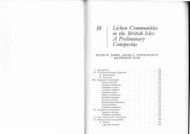You also want an ePaper? Increase the reach of your titles
YUMPU automatically turns print PDFs into web optimized ePapers that Google loves.
subhymenium: structurally diverging from the<br />
hypothecium layer immediately below the<br />
hymenium, only rarely clearly developed.<br />
synanthrop: plants, whose occurrence have been<br />
widened through the activities <strong>of</strong> man (e.g.<br />
limestone dwelling species on walls).<br />
syndrom = chemosyndrom.<br />
thallinocarp: gall-like thallus swelling, in which<br />
asci develop.<br />
thermophytic: warmth loving.<br />
tholus (apical dome): the thickened inner part <strong>of</strong><br />
the ascus-wall at the ascus tip; loosely: clearly<br />
developing at the tip <strong>of</strong> an ascus.<br />
torus: ring structure around the separate lamellae<br />
in the septum <strong>of</strong> Rinodina-spores, in optical<br />
section recognized as a dark point on both sides<br />
<strong>of</strong> the septum near the outer wall.<br />
tuberculate: projecting warty.<br />
unlayered (homoiomerous): algae not limited to<br />
a certain layer or concentrated.<br />
unitunicate: ascus with a wall which does not<br />
split when into two layers when the spores are<br />
ripe (see bitunicate).<br />
cemented: in the case <strong>of</strong> hyphae: hyphae or<br />
paraphyses closely backed to one another,<br />
difficult to loosen from one another.<br />
vertical thallus = secondary thallus.<br />
prothallus: algae-free border about the margin <strong>of</strong><br />
the thallus or the thallus areoles, <strong>of</strong>ten colored<br />
blackish.<br />
warty: thallus with wart-like swellings (larger<br />
than “granules”); warty areolate; areoles convex.<br />
water capacity: water storing capability.<br />
cilia: hair- or bristle-like accessory organs at the<br />
margin <strong>of</strong> thallus lobes, rarely on the margin <strong>of</strong><br />
apothecia.<br />
central strand: in the case <strong>of</strong> Usnea: elastic,<br />
tough central hyphal strand in the filamentous<br />
thallus segment.<br />
dissolving (gelatinizing and disappearing): in the<br />
case <strong>of</strong> paraphyses: strongly slimy, so that in the<br />
ripe hymenium the paraphyses are scarcely or no<br />
longer visible, above all in the pyrenocarpic<br />
lichens.<br />
cilia = bristles.<br />
7 Abbreviations and Clarification Marks<br />
To reduce the size <strong>of</strong> the book, the use <strong>of</strong><br />
numerous signs and abbreviations was<br />
imperative.<br />
µm micrometer (1 µm -0.001 mm)<br />
± more or less<br />
Ap.: apothecium<br />
C+/C-: reaction with hypochlorite positive/<br />
negative (see chapter 3.2.5)<br />
Ch-: lichen substances lacking, no<br />
reaction with K, C, or P<br />
Char.: characteristic species<br />
CK+: reaction with C and later adding K<br />
positive (see chapter 3.2.5)<br />
Epihym.: Epihymenium<br />
Exc.: Exciple<br />
f(hf): photo shows lichen thallus in moist<br />
(semi moist) condition<br />
Ges.: society<br />
GS: Group Key. The key to this genus<br />
takes into consideration species <strong>of</strong><br />
other genera. Which in the genus<br />
key<br />
mentions characters <strong>of</strong> value for<br />
further understanding <strong>of</strong> other<br />
genera.<br />
H: photo <strong>of</strong> herbarium material<br />
Hym.: Hymenium<br />
Hyp.: Hypothecium<br />
Invol.: Involucrellum<br />
I+/I-: reaction with iodine solution (see<br />
chapter 3.2.5)<br />
KC+/KC- reaction with K and later adding C<br />
(see chapter 3.2.5)<br />
K/I+ reaction with I after previous<br />
treatment with K (see chapter<br />
3.2.5)<br />
P+/P-: reaction with P (see chapter 3.2.5)<br />
Paraph.: paraphyses and similar structures<br />
Per.: perithecia<br />
Pseudocyph: pseudocyphellae<br />
Pcynosp.: pycnospores<br />
R-: reactions with K, C, & P negative<br />
s.l.: in the broader sense<br />
Sp.: spores<br />
tol.: tolerant<br />
PT: (part <strong>of</strong> the key). In the case <strong>of</strong><br />
extensive genera the keys are<br />
divided in to various parts.<br />
UV+/UV- in UV light fluorescing or not<br />
fluorescing (see chapter 3.2.5)<br />
v.a. above all<br />
W.: forest, forests<br />
z.: rather, rather strong<br />
zus.: together<br />
7.2 Clarification <strong>of</strong> Symbols<br />
32





